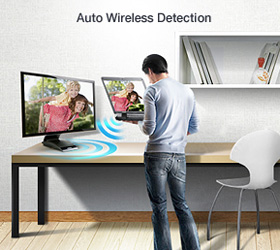Samsung Central Station: The Future of Laptop Docking?
by Kristian Vättö on June 14, 2011 11:30 PM EST- Posted in
- Displays
- Samsung
- Central Station
- Laptops
Back at CES 2011, Samsung showed us something that may have seemed a bit futuristic back then but which is now reality. They showed us a monitor that connects to your laptop wirelessly and on top of that, the monitor acts as a USB hub and the USB devices connect wirelessly too. Samsung calls this technology Central Station. You simply connect a small USB dongle to your laptop, take the laptop within the monitor’s range and your laptop automatically connects to the monitor and peripherals attached to it, wirelessly. You walk away and the monitor goes black. Pretty simple, right?

Background
During the last few years, laptops have become powerful enough for people to use as their main computer. Sales figures support this too. If we look at for example Apple’s sales figures, twice as many desktops were sold compared to laptops in 2002. However, during the recent years, laptops have stolen a huge portion of the sales of desktops, making the situation the opposite of 2002: laptops now outsell desktops by a two-to-one ratio.
While laptops can now offer performance sufficient for some real work, there is one thing that they cannot offer: screen real estate. Most laptops have around a 15” screen, but resolutions vary a lot depending on the model and price range (1366x768 at the low-end, and up to 1920x1200 in higher-end models). 22-24” monitors with resolutions of 1920x1080 have more or less become the standard for desktops and such monitors can be had for ~150$ nowadays.
Because laptops lack screen real estate, a laptop with a separate monitor at home has become a very common setup. This gives you portability when on the go and a desktop-like setup when at home with extra screen size/resolution. However, this kind of setup has one big setback in that you need to plug in a bunch of cables when you get home to use your external monitor and other peripherals. With a desktop, you just turn the computer on or wake it up from the sleep mode; there's no hassling with cables required. While you could call one lazy if it’s too much to plug in a few cables, you often end up either using the laptop on the desk with the monitor all the time, or you never plug in the monitor and it sits on the desk unused.
Laptop docking stations have offered a solution, but there are several shortcomings. First off, not all laptops have a design suitable for docking (Apple’s laptops come to my mind). Second, each laptop dock is only suitable for certain laptop models, so if you buy a new laptop you most likely have to buy a new laptop dock as well. A new dock will easily set you back at least $100, which is quite a lot for an ugly piece of plastic. Finally, many consumer laptops don't even have suitable docks, which rules out a docking station completely.
This is where Central Station becomes interesting. You don't need to connect any cables and you don't need an ugly dock. Everything is wireless.










50 Comments
View All Comments
cosmotic - Wednesday, June 15, 2011 - link
Thats 1000 times slower than what is currently considered standard and 10x slower than what was considered standard the late EIGHTIES!DanNeely - Wednesday, June 15, 2011 - link
Reading fail. "There is also a 100Mb Ethernet port (yeah, you heard it right, Megabit)" It's 100MB, which is faster than wifi if still obsolescent as a wired standard.cjl - Wednesday, June 15, 2011 - link
Not if you have 802.11n...DanNeely - Wednesday, June 15, 2011 - link
wired ethernet has no trouble getting very near its rated speed, wireless never even gets close to it. Despite the theoretical maximum, 802.11n is significantly slower than 100mb wired ethernet.therealnickdanger - Wednesday, June 15, 2011 - link
???100Mb megabits per second = 12.5MB megabytes per second theoretical maximum is not faster than 802.11n. Even with a medium strength signal I can pull over 20MB megabytes from my server over 802.11n.
1000Mb megabit (gigabit) is 10 times faster than 100Mb megabit and is definitely faster than 802.11n in theory and practice.
Spivonious - Wednesday, June 15, 2011 - link
You've had good luck with the n devices then. I tried it out and despite it connecting at 150Mbps, I never got higher than 7-8MB/s file transfers.quiksilvr - Wednesday, June 15, 2011 - link
Chances are you are running on a 2.4 GHz signal, which encounters quite a lot of interference. My suggestion to you would be to switch to a dual band 5 GHz router and make sure the wireless card you are using is 5GHz as well.therealnickdanger - Wednesday, June 15, 2011 - link
Also, if your WAP is connected to a slower hub or switch, that may also be limiting your wireless bandwidth.caziques - Wednesday, June 15, 2011 - link
Reading fail. "Other inputs: 2x USB 3.0, 2x USB 2.0, Megabit Ethernet 2x USB 3.0, 2x USB 2.0, Megabit Ethernet"It's right there in the graph. Megabit Ethernet, just like the OP said.
aldiswilson - Saturday, June 25, 2011 - link
ONLINE STORE :
www styl eown com
-------------------------------------------------------------------------------------------------
1) More pictures available on our website --
3) Perfect quality, small order accepted .
4) 100% safe door to door delivery, within 5 - 7 days air express for small orders .
5) We have lots of jerseys in stock
-------------------------------------------------------------------------------------------------
www style own com
-------------------------------------------------------------------------------------------------
6) Letters and number are sewn on b2cshop body, 100% embroidery
7) Size: .48, 50, 52, 54, 56, 60
8) Delivery by UPS, DHL, EMS door to door
9) Delivery in 5 - 7 days
-------------------------------------------------------------------------------------------------
NFL,NBA,MLB all are 18usd!!!!